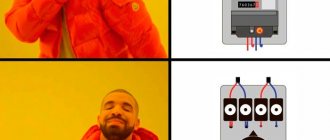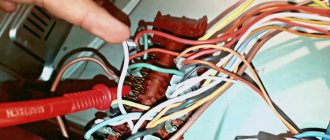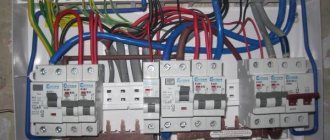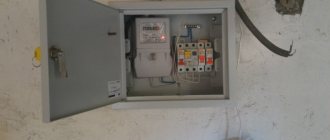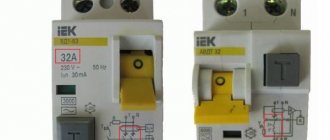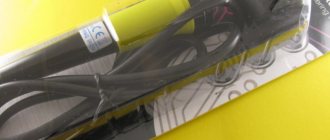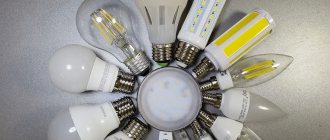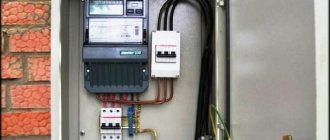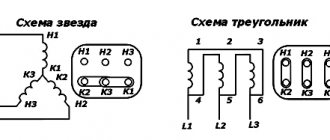You don’t buy voltage stabilizers from a good life, and since you have done this, then you most likely already have or have had problems with voltage.
The standard voltage level, according to regulations, should be 230 volts (not 220, as many still believe).
But depending on the place of residence (the length and congestion of power lines) and possible accidents in the power grid (break of the neutral wire, overload), the voltage can be either consistently low or high, or simply “jump” in arbitrary values.
When a small device is purchased to protect one specific device - a computer, refrigerator, TV, boiler - then there are no problems with connection.
The stabilizer has a plug and socket. Even a schoolboy can figure it out.
But if you want to install a powerful device to protect electrical appliances throughout the house at the same time, then you will have to tinker with the connection diagram.
How to reduce the power of a heating element using improvised means
Last ed. 06 Apr. 21, 13:08 from Zapal
I installed a 1.5 kW heater into the pan. . , what if I connect a kilowatt lamp or two in series with a heating element Cosmo_OD, Apr 06 21, 07:39
Last ed. 06 Apr. 21, 09:52 from Rtehnik
Another idea was born: if I connect a kilowatt lamp or two with a heating element in series, will it/they eat kilowatts from the heating element? If until then how long? The idea has a right to life, since my knowledge of electronics is superficial. Cosmo_OD, 06 Apr. 21, 07:39
when connecting a 1 kW lamp (R=48) and a heating element (R=32), the total power will be 220*220/(48 + 32)=600 W.
Heating element and two kilowatt lamps connected in parallel - 857W
, then on the heating element it’s about 490-500W. miklor, 06 Apr. 21, 10:22
Last ed. 06 Apr. 21, 12:15 from Viktrych
500 watts, Is it possible then to simply connect a 2 kW lamp and a heater in series and get the same level as 500?
Turn on the diode Viktrych, 06 Apr. 21, 09:10
Can you be a little more specific about what kind of diode I need to look for?
I also have a transformer 220>110 at 500V, if I connect it through it and give 110 volts to the heater, will it work at half power?
Last ed. 06 Apr. 21, 12:17 from Cosmo_OD
The diode you need is Viktrych, Apr 06. 21, 12:38
It won’t do anything.. The heating element will heat 250 watts..
I probably won’t be able to handle it with a diode, Cosmo_OD, Apr 06. 21, 12:50
Do you have a ship's electrician? Don't get caught up in the details...
go up to him and say - I need a diode for a 1500 watt heating element - reduce the power by half. He will select it himself - if you agree... At the very least, he will rent out a thread - excessively powerful, 200 amperes)). Anything from the spare parts of the ship's generator... then you will return it...
Last ed. 06 Apr. 21, 13:11 by Zapal
I won’t get the fuse off the head normally on a primitive blowing 750V. I would like someone to answer the norm for a 2 kW lamp, but the transformer will also work with 350+, I think slowly if :)
If there was an electrician who remembered this, I wouldn’t create a topic here :)))
Last ed. 06 Apr. 21, 14:03 from Cosmo_OD
I would like someone to answer the norm for a 2kW lamp Cosmo_OD, Apr 06. 21, 14:01
to answer correctly, you need normal numbers... the exact voltage value, the exact resistance of the lamp... the fact is that tungsten changes resistance when heated... everything turns into a guessing game...
If you measure the current consumption, heating element + lamp, we will tell you exactly..
If there was an electrician who remembered this, I wouldn’t create a topic here :))) Cosmo_OD, April 06. 21, 14:01
Source
Power minimizer - saving or cheating the meter?
An active reader, commentator and author of the SamElectric.ru blog, Alexey Filippov, comprehensively examines and rightly criticizes the patent for an invention and a real device that supposedly saves electricity.
Saving electricity and saving money are two big differences, which I write about in detail in my article about Ways to Save Energy.
In addition, Alexey’s article is closely related to my article “Methods of theft of electricity,” which was significantly cut down at the request of Roskomnadzor.
The device is sold on the Internet, it is very expensive, and this article is a review of this device.
Energy efficient operation of water heaters
To avoid overpayments for utilities, you need to figure out how to properly and effectively use a household boiler to rationally save water and electricity. There are several ways.
Waste water heat recovery
Between 80 and 90% of hot water's energy is lost to the drain. Installing the system allows you to use the heat of the waste liquid to heat the cold one. In apartments and houses it is advisable to use 2 types of equipment:
- with buffer capacity. Justified when using a washing machine or dishwasher. The effluent passes through a spiral tube in the tank, and its heat warms the water, which is pushed upward. The water returns to the boiler in a preheated state;
- without buffer capacity. A copper heat exchanger in the form of a spiral is wound onto the sewer sections. Preheated water also returns through it.
Important! Depending on the intensity of use, the payback period for such equipment is 2.5-7 years
Heat traps
When the heater pipes are connected from above, the water rises and always heats the pipes. Convection loops conduct heat into the air where it is wasted. Installing anti-convection channels at the points where the pipeline connects to the heater will increase the energy efficiency of the boiler.
Heat traps can be made by tying vertical pipes horizontally. To prevent heat transfer, plastic inserts are made at the junction of the pipes and heaters.
Reducing the water temperature in the water heater
There is a program switch on the outer panel. By setting mode E (economical), you will heat the water to 55-60 degrees. The savings consist of increasing the resource of the heating element without wasting energy.
On the LCD panel, the Eco mode can be programmed to turn on at the desired time. For mechanically controlled boilers, just turn the handle.
Location of control mechanisms
Savings in boiler operation ensure a reduction in utility bills. There are many ways to improve the energy efficiency of an appliance. When choosing a specific option, be guided by the type of water heater and its displacement.
Watch a video about how to save energy
IS IT POSSIBLE TO LEGALLY FICTION THE ELECTRIC METER?
It seems that not so long ago they were actively selling a certain box everywhere, I don’t remember the name, that saves electricity. I somehow immediately suspected a trick, but I was curious, and then my suspicions were confirmed when I saw the opening of such a box, and it turned out to have a regular capacitor and a pair of indicator LEDs installed in it with a circuit for powering them. I won’t say that this device is completely useless or a fake, but it is of little use.
In the advertisement, the video showed a fluorescent lamp, the current consumption of which decreased when a “magical and very necessary” device was connected. After I saw what was inside, I understood how it works, the device simply compensates for the reactive load, the lamp used in the advertisement had a throttle ballast.
If the load is resistive or capacitive in nature, or weakly inductive (cos φ > 0.9), then the device will have virtually no effect on electricity consumption. However, in some cases, the device allows you to actually save a little, without cheating. The same cannot be said about the device that will be discussed below.
There are several questions, why this device was sold to us at such a high price, what will happen if the device is connected to the network, but there is no reactive, that is, inductive load... why is it needed at all, if our meters do not take into account the reactive load at all...
Of course, there will be some savings, but it will be negligible, due to the reduction in losses due to the resistance of the wires running from the meter to the outlet where the device is turned on, and then only under ideal conditions, as in advertising - inductive reactive load! In a word, a waste of money for a purchase!
Checking the circuit
The first switch-on must be done without load. That is, all machines except the input one and the one that goes to the stabilizer must be turned off.
Start it at idle speed and monitor its operation. Input and output parameters, whether there is any extraneous noise or squeaking.
It also wouldn’t hurt to check the correctness and accuracy of the technical data displayed on the electronic display.
If you have a three-phase 380V network at home, then for this connection it is recommended to use 3 single-phase voltage stabilizers, each connected to a separate phase.
More details about the advantages of three-phase and single-phase devices and when to choose which one can be found in the article “How to choose a voltage stabilizer for your home.”
Losses and types of loads
A little theory, but without abstruse formulas, so to speak, for dummies. Those who have studied electrophysics know that there are losses during the transmission of electricity, and in networks with alternating current everything is much more complicated than in the case of direct current; in addition to Ohm’s law, there are a bunch of other laws and effects that cause losses to increase.
A significant contribution to losses, in addition to all others that we will not consider, is the power factor (cos φ), the higher it is, the lower the losses. The ideal load is active, from the point of view of minimal losses in the wires, for example, an electric heater with a heating element, its power factor is 1.
Inductive and capacitive reactance separately are two types of reactance, but with opposite phase shifts; if they are connected in parallel, then with the correct calculation of the ratings they compensate each other. Any of the two types of reactance is harmful because it causes current in the networks. No work is done, (cos φ
For example, you can calculate the losses that a household meter must take into account if a reactive load is turned on. I calculated everything in the ElectroDroid program.
If you connect a reactive load to the network - a capacitor with a capacity of 5 μF, such as in the device described above, then a current of approximately 0.5 A will flow in the network.
A device for saving on the basis of thyristors - Tarasov minimizer
Let's get to the main topic of the article. I somehow came across an inventor who invented a device for “saving money.”
At the beginning, I decided that in order to save money, the device should somehow combat reactive (harmful) resistance, preferably so that this would also happen automatically, for maximum effect. Theoretically, having removed the reactive component, the device will still not be able to provide such great savings as the author of the invention promises, I began to figure it out...
The principle of operation of the “saving device” turned out to be slightly different.
Patent link: www.freepatent.ru/patents/2451974
A website with a detailed description where you can order a device for saving electricity MIM elektromb.ru:
The site has been down for a couple of years now.
Everything is serious and should inspire confidence, this is not just a video on YouTube!
The circuit specified in the patent can work as a regular dimmer assembled on two powerful thyristors. Savings should occur by reducing the voltage in the electrical network directly where the load will be turned on. This idea seems absurd to me, since it will simply reduce the power of electrical appliances and, accordingly, reduce their efficiency - heaters will heat less, light bulbs will shine weaker, etc.
Everything is more complicated; the truth is not visible at first glance. The author suggests buying a 100 uF non-polar capacitor in the kit (and it costs a lot!), turning it on after your device (MIM) and here a real miracle, or rather magic, happens!
A miracle is nothing more than a deception of the metering device! Simply, the counter goes crazy and starts counting less!
Any thyristor is a semi-controlled semiconductor device, that is, you can control its opening by applying a pulse to the control electrode, and the thyristor opens instantly (avalanche-like) - this is the key point, since the thyristor creates a pulsed noise, but the thyristor closes only when the current through the anode and cathode of the thyristor will become less than the holding current when the sine wave passes through 0. Here in the description of the work I found an error.
Quote description of operation from the text of the patent for the MIM power minimizer:
“By selecting the resistance of the control electrode circuit, you can achieve a moment when the thyristor turns off and turns on again at the crest of a half-wave a little closer or a little further, or several times during the entire passage of the half-wave, and not only when the half-wave completely passes through zero. Since the power of the load is determined by the amount of energy received into it, from zero, to the top and a little further than the half-wave of the sine wave, we can confidently say that the decreasing energy of the second half of the half-wave, the one beyond the top, is not used for work and is lost. By cutting off, for example, the top of a half-wave of a sine wave, MIM allows you to partially cut off, like a phase regulator, part of the first half of a half-wave of a sine wave and, like MIM, part of the second, decreasing half-wave of a sine wave, thereby saving energy.”
It is impossible to switch off the thyristor in principle by selecting the resistance in the control electrode circuit! An error in the description of the work does not affect the operation of the device at all, the DEVICE WORKS! But precisely as a generator of powerful impulse noise in the electrical network!
In fact, this is how everything happens: the thyristor opens (avalanche-like), a capacitor of impressive capacity is instantly connected to the network, which causes a large current surge and voltage drop, the shape of the sine wave is distorted. The 100 µF capacitor is discharged through the load. At the next half-wave, the capacitor is charged again, and the process is repeated. The author simply selected the values of the capacitor and the circuit so that the circuit generates interference into the mains voltage sufficient for the non-sinusoidality of the mains voltage to introduce an error into the operation of the meter.
A high-frequency component appears (high rate of signal rise); in simple words, the meter “does not have time” to count the capacitor charge cycle. Brilliant and simple, bravo! The operation of the device has nothing to do with reactive power correction.
Source
Stabilizer connection
Now let's move on to directly connecting the stabilizer itself. In order to get to its contacts, you may need to remove the outer cover.
Pass two cables (input and output) through the holes and clamp them under the terminals according to the following diagram:
- Tighten the phase conductor of the stabilizer input cable to the INPUT terminal (Lin)
- neutral wire (blue) to terminal N (Nin)
- grounding conductor to the screw terminal marked “ground”
By the way, there may not be a separate ground terminal. Then screw this core into a screw on the device body itself.
There are models with terminal blocks for only 3 wires. In them only the phase returns back.
Zero for powering electrical appliances is taken from the common panel.
Now that you have applied voltage from the shield to the stabilizer, you need to return this voltage, but already stabilized, back to the common shield.
To do this, connect the cable - the output from the stabilizer.
- its phase conductor to the OUTPUT terminal (Lout)
- zero to N (Nout)
- grounding conductor, in the same place as the grounding conductor from the input cable
Visually check the entire circuit again and close the lid.
Technology news
How to reduce the total power consumption of energy-intensive electrical appliances, reduce the load on the electrical network, prevent overloading of wiring and shutdown of the machine, and meet the permitted power limit
In a private house with a power line power of 3.5 kW, it is necessary to use two electric convectors of 1 kW each, a storage water heater of 1 kW and an electric kettle of 1 kW. In total, the total power of electrical appliances is 4 kW .
More recently, any schoolchild familiar with the basics of electrical engineering would have said that it was impossible to solve such a problem. And an electrician would warn that when consumers are turned on, with a total power exceeding the permitted power of the electrical network, the electrical wiring will be overloaded. In this case, the automatic switch at the input (16A), located in the electrical panel, next to the electricity meter, will inevitably turn off. The machine will break, and the house will be left without electricity. And this is not the worst consequences of wiring overload. Repeated overloads lead to damage to the wire insulation, subsequent short circuits and fire.
However, with the development of technology, a simple solution to the problem of insufficient network power has appeared, accessible even to a schoolchild. To solve our problem, we will need two household load optimizers OEL-820.
Let's start with connecting electric convectors. The priority heating device in the left room on the second floor is connected to the socket through block A of the OEL-820 load optimizer, and the non-priority heating device in the right room is connected through block B.
Let's consider how heating devices will work.
When priority electric convector A is switched on in heating mode, non-priority electric convector B is switched off. As soon as the temperature in the left room reaches the set value, electric convector A will turn off the heating. The operating cycle of non-priority appliance B will begin.
When the temperature in the right room reaches the set value, electric convector B will switch off. For some time, depending on the quality of the thermal insulation of the premises, both electric convectors can be turned off. At this time, the temperature in the left room slowly decreases.
When the temperature drops below the set value, priority electric convector A will turn on and begin its new operating cycle.
Since in a pair of electric convectors on the second floor one and only one electric convector can be turned on, their total power consumed from the network in our case will never exceed 1 kW. Consequently, their consumption and the load on the power grid will be halved!
Determining the efficiency of a new water heater
How to start using your new boiler economically and correctly? Experts focus on determining its energy efficiency when purchasing.
General rules
Before purchasing equipment, the user needs:
- compare the energy efficiency of expensive and budget models in the store to establish the return on investment of the equipment;
- clarify that the energy efficiency class includes efficiency, losses per hour during heating and maintaining temperature, circulation. Information is indicated in the manufacturer's booklet;
- take into account the displacement of the container, the operating speed of the heating element, the type of installation to clarify the total costs.
Interesting to know! On European boiler models, energy efficiency has been indicated since 2013, on American ones - since 2009.
Calculation of annual operating costs
For calculations, you will need information about the energy efficiency class, type and cost of the coolant. Further calculations are performed using the formula:
- for gas models, the number of days per year is multiplied by energy efficiency and the cost of a cubic meter of gas;
- for electric boilers, the number of days per year is multiplied by energy efficiency and the cost of kW/hour.
Interesting to know! The DOE test for water heaters takes into account cold (15 degrees) and hot (60 degrees) temperatures and determines the unit's performance for a family of 3 as 240 liters per day.
Heating element power as a saving factor
The greater the power of the heating element, the faster the water will heat up. Keep in mind that in houses with a single-phase wiring diagram, from 7 to 10 kW of power are allocated. A high-performance water heater will lead to increased load on the network, huge energy costs and tripping of circuit breakers.
